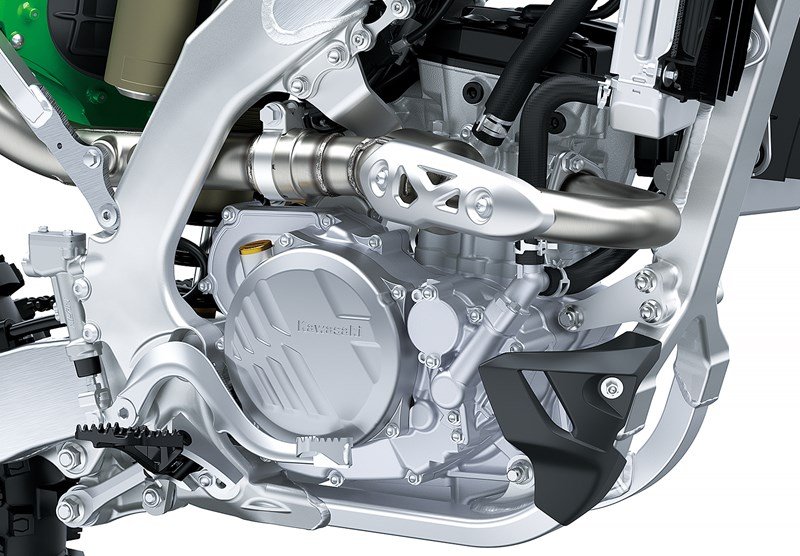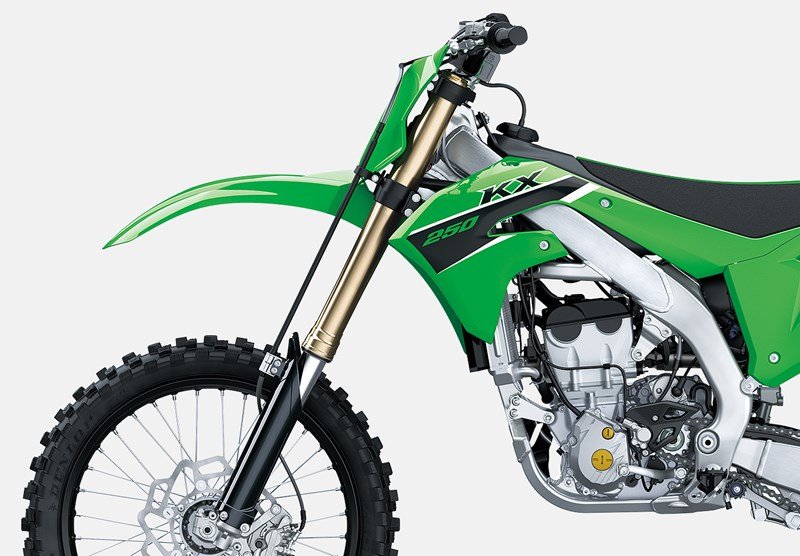








2023 Kawasaki KX250
- Location:
- Blackstock Motorsports
Engine Management TechnologyDUAL INJECTORS The Kawasaki KX250F was the first mass-production motocross bike to feature Dual Injectors. One injector is located downstream of the throttle valve, where injectors are located on standard FI systems, and a second is located upstream of the throttle valve, close to the airbox. The two injectors split their roles: operating at different rpm ranges, they ensure both smooth, instant response at low-rpm and high peak power at high-rpm. For cases that call for low-rpm operation like instantaneous acceleration off the start and precise control when cornering, primary operation falls to the downstream injector. Because it is positioned close to the combustion chamber, sprayed fuel can be supplied to the engine quickly, resulting in sharp response. Conversely, when high power is the priority, primary operation switches to the upstream injector, which focuses on high-rpm applications. Its location farther away from the combustion chamber means that the fuel has a longer travel time. This allows more time for the fuel particles and air to mix, as well as allowing the mixture to cool and condense. This means that when more power is needed, the cylinder can be filled with a greater quantity of high-quality mixture. |
|
LAUNCH CONTROL MODE In motocross racing, getting a good start is critical. A few tenths of a second can make the difference between getting the holeshot or not. In slippery conditions, getting the maximum drive from a motocrosser requires precise control of the both the clutch and throttle. Launch Control Mode helps riders get a good start by complementing high-level technique with engine management. Featured on a mass-production motocrosser for the first time on the Kawasaki KX450F, the system activates a separate engine map designed to get a more efficient start off the line. The system is designed to the same specifications as that used by our factory racers competing in the AMA Supercross and Motocross championships. Launch Control Mode is activated simply by pressing the button on the handlebar. The Launch Control map slightly retards ignition timing to help tame the engine's strong torque and reduce wheel spin off the start. Launch Control Mode is only active in the first two gears after the launch, disengaging and returning to the standard engine map automatically once the rider shifts into third gear. The system gives riders a great advantage when lining up at the gate and puts them in a better position to win. |
Chassis Management TechnologyERGO-FIT Proper fit is key for rider comfort and control. However, the ideal fit varies from rider to rider, depending on their physical dimensions and riding style. ERGO-FIT is an interface system designed to allow riders to find their ideal riding position. Various points of the chassis interface (the handlebar, footpegs and seat, etc.) can be adjusted through a combination of interchangeable parts and parts with adjustable positions. This enables a wide range of riders to find a riding position that offers both comfort and control. Feeling at one with their machine, they will be able to experience how Kawasaki machines are fun and rewarding to ride. |
FACTORY-STYLE ENGINE COMPONENTS AND TUNING
|
FACTORY-STYLE CHASSIS COMPONENTS AND TUNING
|













FEATURING
ADDITIONAL VEHICLE FEATURES